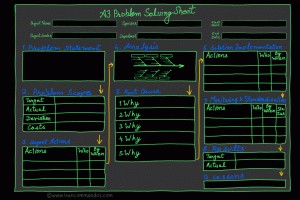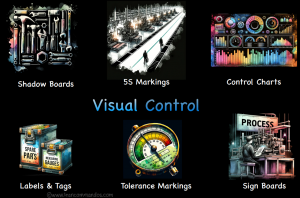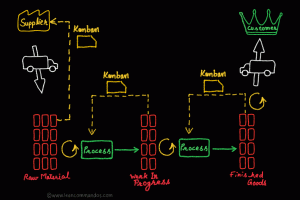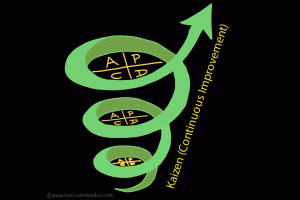Introduction
In the realm of Lean management, the Gemba Walk stands out as a transformative tool that encourages leaders to step out of their offices and engage with the front-line work environment. The term ‘Gemba’ translates to ‘the real place’ in Japanese, where the value is created and where the real action happens
History and Development
In the realm of Lean management, the Gemba Walk stands out The Gemba Walk has its roots in the Japanese management practices that were part of the Toyota Production System. It was developed as a means to understand the work process, engage with employees, and identify opportunities for improvement.as a transformative tool that encourages leaders to step out of their offices and engage with the front-line work environment. The term ‘Gemba’ translates to ‘the real place’ in Japanese, where the value is created and where the real action happens
When to Use the Tool
A Gemba Walk is particularly useful when problems need to be observed firsthand, when processes are being updated or changed, or when there is a need to foster a culture of continuous improvement. It’s a tool that brings management closer to the operational front line and provides clear, actionable insights.

How It Works
Implementing a Gemba Walk involves a structured approach that begins with a clear objective. Leaders must decide what they want to observe and why. This might be a specific process, a particular problem area, or simply to gain an overall understanding of the work being done.
The next step is to plan the walk. This means determining the areas to be visited, the people to be engaged with, and the questions to be asked. A Gemba Walk is not an audit; it’s an opportunity to observe and learn. Leaders should approach it with an open mind, ready to listen and understand, not to judge or criticize.
During the walk, it’s crucial to observe the process, ask questions, and show respect to the employees. The focus should be on the process, not the individual performance. Questions should be open-ended, such as “Can you walk me through this process?” or “What challenges are you facing here?”
After the walk, it’s important to reflect on the observations and discussions. This reflection should then be turned into action. The Gemba Walk is not just about observing; it’s about acting on the insights gained to make real improvements.
Key to the success of a Gemba Walk is consistency. Regular walks signal to employees that management is genuinely interested in the work being done and is committed to supporting the team in improving processes.
Benefits
The benefits of a Gemba Walk are manifold. It promotes transparency, improves communication between management and staff, identifies inefficiencies, and empowers employees to suggest improvements. It also helps in building a culture of trust and collaborative problem-solving.
Common Mistakes and Pitfalls
Common mistakes during Gemba Walks include not having a clear focus, neglecting to follow up on observations, and failing to involve or listen to employees. It is also a mistake to use the walk as a form of surveillance, which can erode trust and stifle open communication.

Tips for Success
To succeed with Gemba Walks, plan your walks thoughtfully, listen more than you speak, focus on process over people, take notes, and most importantly, ensure follow-up actions are taken. Respect and genuine curiosity are your greatest tools.
FAQs
What is the best time to conduct a Gemba Walk?
Conduct Gemba Walks at various times to get a full picture of the operations.
Who should be involved in a Gemba Walk?
It should include cross-functional team members for diverse perspectives.
How often should Gemba Walks be conducted?
Regularly, but frequency can vary based on the organization’s needs.
Do Gemba Walks disrupt the workflow?
If conducted respectfully, they should not disrupt but rather enhance workflow.
How do you track improvements from Gemba Walks?
Use tracking tools like action item lists or performance boards for follow-ups
Integration With Other Lean Tools
The Gemba Walk can be integrated with other Lean tools like 5S for workplace organization, Kaizen for continuous improvement, and PDCA(Cycle) for problem-solving and visual management to ensure that the improvements from the Gemba Walks are standardized and maintained.
References and Further Reading
For those seeking to expand their knowledge of the Gemba Walk, the following books are highly recommended:
- “Gemba Kaizen: A Commonsense Approach to a Continuous Improvement Strategy” by Masaaki Imai
- “The Toyota Way: 14 Management Principles from the World’s Greatest Manufacturer” by Jeffrey Liker
- “Lean Thinking: Banish Waste and Create Wealth in Your Corporation” by James P. Womack and Daniel T. Jones
These texts offer a wealth of information from the pioneers of Lean thinking and provide practical insights that can be applied in any organization looking to implement the Gemba Walk as a tool for improvement.







7 Responses
I was suggested this website by my cousin. I’m not sure whether this post is written by him as no one else know such detailed about my trouble. You’re amazing! Thanks!
I’m not that much of a internet reader to be honest but your sites really nice, keep it up! I’ll go ahead and bookmark your site to come back later. Many thanks
superb post.Ne’er knew this, thanks for letting me know.
Generally I do not read post on blogs, but I would like to say that this write-up very forced me to try and do it! Your writing style has been surprised me. Thanks, very nice post.
Perfect piece of work you have done, this web site is really cool with good info .
Some really nice stuff on this internet site, I love it.
Really superb information can be found on website.